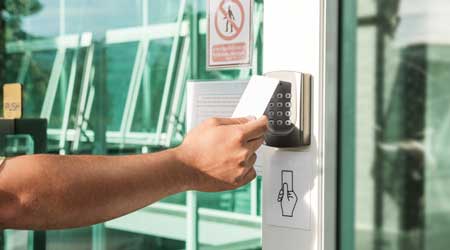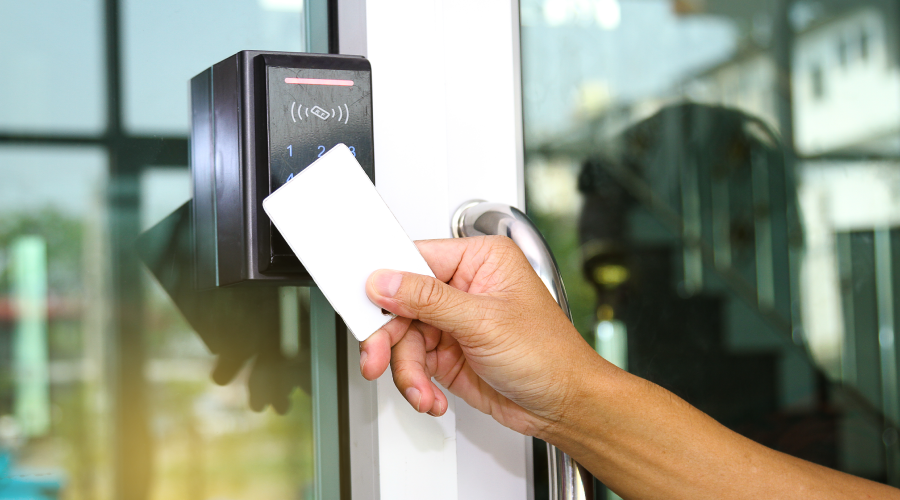 Technology such as key cards enables managers to improve security while avoiding the need for occupants to touch door hardware surfaces.
Technology such as key cards enables managers to improve security while avoiding the need for occupants to touch door hardware surfaces.Security Issues: Successful Door Hardware Upgrades
Coronavirus considerations join the list of issues managers must weigh in specifying door hardware components
Upgrade projects offer managers important opportunities to take steps that improve facility security, as well as occupant and visitor health.
Some electronic door hardware choices, such as proximity cards, biometric readers, and facial recognition, have the ability to limit entry only to authorized personnel and record the time and place of entry. They can combine access control and daily attendance records in one system, eliminating the need for time clocks.
This hardware also can be set to limit the times that access is authorized, and it can log activity, providing greater security than conventional mechanical lock-and-key systems. Some facial recognition door hardware has capacity for multiple means of identification, such as fast facial recognition, password, fingerprint reader, and key. During emergencies that can include health crises, managers can implement selective admittance by deactivating the cards of all but a few security and emergency personnel and first responders.
Among the factors that managers need to consider when upgrading manual locks are the following:
• Is a 100 percent electro-mechanical, heavy-duty, pushbutton lock an option?
• Is the lock made to the most robust ANSI/BHMA Grade 1 standards? The added cost is a good bargain when considering the safety and security of occupants, and the longer useful life.
• Is it fully bump-proof and pick-proof? Intruders have found ways to use bump methods to open some locks in seconds. Likewise, they can make a set of picks that will open some locks just as quickly.
• Are there 1 million possible key combination choices?
• Does the lock have a heavy-duty latch bolt with a deadlocking plunger?
• Will its dimensions allow it to fit standard ASA 161 door hole diameter with standard backset of 2 3/4 inches or 2 ⅜ inches?
• Can it be used for right-hand or left-hand doors?
• Are all installation, operation and maintenance manuals included with the order?
• What maintenance is required, including tasks related to batteries, wires, and wifi support?
• Is a manufacturer warranty included?
If managers plan to replace aging door hardware, now is the time to consider following some practices used in the healthcare industry, such as specifying antimicrobial door hardware and fitting doors with non-contact, sensor-operated, electro-mechanical openers. The only regular maintenance involves keeping antimicrobial hardware clean. Antimicrobial properties are retained on the hardware for its lifetime.
The EPA has activated its Emerging Viral Pathogen Guidance program, released for the first time in January 2020. This program includes a list of disinfectants that are effective against the coronavirus. It is good practice to be familiar with the safety data sheets for these products so that workers wear proper personal protective equipment and practice proper handling and cleanup practices.
Thomas A. Westerkamp is a maintenance and engineering management consultant and president of the work management division of Westerkamp Group LLC. Westerkamp is also author of “Community Association Manager’s Standard Manual and Guide,” https://amzn.to/2ZE7jlr.
Related Topics:














